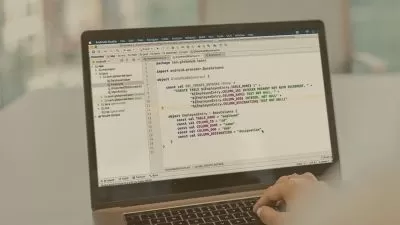Mastering SQLite: From Fundamentals to Advanced Techniques
Tech Academy
4:00:23
Description
Become a SQLite Expert: Practical Skills for Real-World Applications
What You'll Learn?
- Understand the fundamental concepts and architecture of SQLite.
- Install and configure SQLite on different operating systems.
- Execute and optimize SQLite SELECT statements for data retrieval.
- Filter and sort data using WHERE and ORDER BY clauses.
- Eliminate duplicate records using the DISTINCT clause.
- Understand and apply various SQLite data types.
- Use SQLite aliases for improving query readability.
- Define and enforce constraints in SQLite tables.
- Create, update, and delete database tables using SQL statements.
- Perform data manipulation tasks such as inserting, updating, and deleting records.
- Drop tables and manage database schema changes.
- Utilize SQLite operators like BETWEEN, IN, LIKE, and GLOB for advanced querying.
- Construct and execute subqueries in different parts of SQL statements.
- Implement various types of joins (LEFT, INNER, CROSS, SELF) to combine data from multiple tables.
- Leverage aggregate functions and clauses to summarize data (AVG, COUNT, SUM, MAX, MIN, GROUP BY, HAVING).
- Apply string, numeric, and date/time functions to manipulate and format data.
- Create and use indexes to improve query performance and implement optimization techniques for efficient database operations.
Who is this for?
What You Need to Know?
More details
DescriptionAre you ready to unlock the full potential of SQLite for your data management needs? Welcome to "Mastering SQLite: From Fundamentals to Advanced Techniques," a comprehensive course designed to equip you with the knowledge and skills needed to proficiently manage and manipulate databases using SQLite. Whether you're a novice stepping into the world of databases or a seasoned professional aiming to refine your expertise, this course is tailored to meet your needs.
What is SQLite and Why Should You Learn It?
SQLite is a powerful, self-contained, serverless, and zero-configuration SQL database engine. It's widely used in various applications, from mobile apps to embedded systems, due to its simplicity and reliability. Learning SQLite opens up numerous opportunities to enhance your data management capabilities, whether you're developing software, analyzing data, or managing IT systems.
Who Should Take This Course?
This course is ideal for a broad audience, including:
Aspiring Database Developers: Individuals seeking to build a strong foundation in database management and SQL.
Software Developers: Programmers looking to integrate SQLite into their applications for efficient data storage and retrieval.
Data Analysts and Data Scientists: Professionals who need to manage, query, and analyze data stored in SQLite databases.
IT and Systems Administrators: Technical staff responsible for managing databases and ensuring data integrity within their organizations.
Students and Academics: Learners in computer science, information technology, and related fields who require a comprehensive understanding of SQLite for their studies and projects.
Tech Enthusiasts: Hobbyists interested in exploring database management systems and SQL.
Professionals Transitioning into Tech: Individuals from non-technical backgrounds aiming to acquire new skills in database management and SQL for career advancement.
Course Structure and Content
This course is structured to provide a balanced mix of theoretical concepts and practical applications. It is divided into several sections, each focusing on key aspects of SQLite:
Section 1: Introduction to SQLite
Lecture 1: Introduction
Lecture 2: What is SQLite?
Lecture 3: Why Use SQLite?
Section 2: Setting Up Your Environment
Lecture 4: Download and Install SQLite (Preview enabled)
Lecture 5: Tools and Interfaces for SQLite
Lecture 6: What is SQLite Studio?
Lecture 7: Attaching Sample Database to SQLite
Lecture 8: How to connect to SQLite Database
Lecture 9: Database Concepts
Lecture 10: What is sqlite3 tool (Preview enabled)
Lecture 11: Some Basic SQLite3 Commands
Lecture 12: SQLite Dump command
Section 3: Basic Concepts and Terminology
Lecture 13: Databases, Tables, and Records
Lecture 14: SQL Basics
Section 4: Data Manipulation
Lecture 15: SQLite SELECT statement
Lecture 16: Querying data from all columns in a table
Lecture 17: Querying data from specific columns in a table
Lecture 18: Sorting data using ORDER BY clause
Lecture 19: Removing duplicate records using DISTINCT clause
Lecture 20: Filtering data with WHERE clause
Lecture 21: Identifying NULL values
Lecture 22: SQLite Data Types
Lecture 23: SQLite Aliases
Section 5: Creating Database Tables | Updating Data | Deleting Records
Lecture 24: SQLite Constraints
Lecture 25: SQLite Create Table Statement - Part 1
Lecture 26: SQLite Create Table Statement - Part 2
Lecture 27: SQLite INSERT INTO Table Statement
Lecture 28: SQLite UPDATE Statement
Lecture 29: SQLite DELETE Statement
Lecture 30: SQLite DROP Table Statement
Section 6: SQLite Operators
Lecture 31: SQLite BETWEEN Operator
Lecture 32: SQLite IN Operator
Lecture 33: SQLite LIKE operator
Lecture 34: SQLite GLOB Operator
Lecture 35: SQLite LIMIT clause
Section 7: Working with Subqueries
Lecture 36: What is a subquery?
Lecture 37: Building a subquery in a WHERE clause
Lecture 38: Building a subquery in a WHERE clause using IN operator
Lecture 39: Building a subquery in FROM clause
Section 8: Joining Tables
Lecture 40: SQLite LEFT Join
Lecture 41: SQLite INNER Join
Lecture 42: SQLite CROSS Join
Lecture 43: SQLite SELF Join
Section 9: Aggregating Data
Lecture 44: Introduction to SQLite Aggregate Functions
Lecture 45: SQLite AVG Function
Lecture 46: SQLite COUNT Function
Lecture 47: SQLite SUM Function
Lecture 48: SQLite MAX Function
Lecture 49: SQLite MIN Function
Lecture 50: SQLite GROUP CONCAT Function
Lecture 51: SQLite GROUP BY Clause
Lecture 52: SQLite HAVING Clause
Section 10: SQLite Functions
Lecture 53: String Functions
Lecture 54: Numeric Functions
Lecture 55: Date and Time Functions
Section 11: Indexes and Optimization
Lecture 56: Creating and Using Indexes
Lecture 57: Analyzing Query Performance
Lecture 58: Optimization Techniques
Learning Outcomes
By the end of this course, you will:
Understand and explain the core concepts and benefits of SQLite.
Set up and configure SQLite on various operating systems.
Use tools like SQLite Studio and the sqlite3 command-line tool to interact with databases.
Create, update, and manage SQLite databases and tables.
Perform complex data queries and manipulations using advanced SQL techniques.
Implement constraints and handle different data types effectively.
Optimize database performance through indexing and other techniques.
Join us on this comprehensive journey to mastering SQLite and revolutionize how you handle data in your applications and projects. Enroll today and take the first step towards becoming an SQLite expert!
Who this course is for:
- Aspiring Database Developers
- Software Developers
- Data Analysts and Data Scientists
- IT and Systems Administrators
- Students and Academics
- Tech Enthusiasts
- Professionals Transitioning into Tech
Are you ready to unlock the full potential of SQLite for your data management needs? Welcome to "Mastering SQLite: From Fundamentals to Advanced Techniques," a comprehensive course designed to equip you with the knowledge and skills needed to proficiently manage and manipulate databases using SQLite. Whether you're a novice stepping into the world of databases or a seasoned professional aiming to refine your expertise, this course is tailored to meet your needs.
What is SQLite and Why Should You Learn It?
SQLite is a powerful, self-contained, serverless, and zero-configuration SQL database engine. It's widely used in various applications, from mobile apps to embedded systems, due to its simplicity and reliability. Learning SQLite opens up numerous opportunities to enhance your data management capabilities, whether you're developing software, analyzing data, or managing IT systems.
Who Should Take This Course?
This course is ideal for a broad audience, including:
Aspiring Database Developers: Individuals seeking to build a strong foundation in database management and SQL.
Software Developers: Programmers looking to integrate SQLite into their applications for efficient data storage and retrieval.
Data Analysts and Data Scientists: Professionals who need to manage, query, and analyze data stored in SQLite databases.
IT and Systems Administrators: Technical staff responsible for managing databases and ensuring data integrity within their organizations.
Students and Academics: Learners in computer science, information technology, and related fields who require a comprehensive understanding of SQLite for their studies and projects.
Tech Enthusiasts: Hobbyists interested in exploring database management systems and SQL.
Professionals Transitioning into Tech: Individuals from non-technical backgrounds aiming to acquire new skills in database management and SQL for career advancement.
Course Structure and Content
This course is structured to provide a balanced mix of theoretical concepts and practical applications. It is divided into several sections, each focusing on key aspects of SQLite:
Section 1: Introduction to SQLite
Lecture 1: Introduction
Lecture 2: What is SQLite?
Lecture 3: Why Use SQLite?
Section 2: Setting Up Your Environment
Lecture 4: Download and Install SQLite (Preview enabled)
Lecture 5: Tools and Interfaces for SQLite
Lecture 6: What is SQLite Studio?
Lecture 7: Attaching Sample Database to SQLite
Lecture 8: How to connect to SQLite Database
Lecture 9: Database Concepts
Lecture 10: What is sqlite3 tool (Preview enabled)
Lecture 11: Some Basic SQLite3 Commands
Lecture 12: SQLite Dump command
Section 3: Basic Concepts and Terminology
Lecture 13: Databases, Tables, and Records
Lecture 14: SQL Basics
Section 4: Data Manipulation
Lecture 15: SQLite SELECT statement
Lecture 16: Querying data from all columns in a table
Lecture 17: Querying data from specific columns in a table
Lecture 18: Sorting data using ORDER BY clause
Lecture 19: Removing duplicate records using DISTINCT clause
Lecture 20: Filtering data with WHERE clause
Lecture 21: Identifying NULL values
Lecture 22: SQLite Data Types
Lecture 23: SQLite Aliases
Section 5: Creating Database Tables | Updating Data | Deleting Records
Lecture 24: SQLite Constraints
Lecture 25: SQLite Create Table Statement - Part 1
Lecture 26: SQLite Create Table Statement - Part 2
Lecture 27: SQLite INSERT INTO Table Statement
Lecture 28: SQLite UPDATE Statement
Lecture 29: SQLite DELETE Statement
Lecture 30: SQLite DROP Table Statement
Section 6: SQLite Operators
Lecture 31: SQLite BETWEEN Operator
Lecture 32: SQLite IN Operator
Lecture 33: SQLite LIKE operator
Lecture 34: SQLite GLOB Operator
Lecture 35: SQLite LIMIT clause
Section 7: Working with Subqueries
Lecture 36: What is a subquery?
Lecture 37: Building a subquery in a WHERE clause
Lecture 38: Building a subquery in a WHERE clause using IN operator
Lecture 39: Building a subquery in FROM clause
Section 8: Joining Tables
Lecture 40: SQLite LEFT Join
Lecture 41: SQLite INNER Join
Lecture 42: SQLite CROSS Join
Lecture 43: SQLite SELF Join
Section 9: Aggregating Data
Lecture 44: Introduction to SQLite Aggregate Functions
Lecture 45: SQLite AVG Function
Lecture 46: SQLite COUNT Function
Lecture 47: SQLite SUM Function
Lecture 48: SQLite MAX Function
Lecture 49: SQLite MIN Function
Lecture 50: SQLite GROUP CONCAT Function
Lecture 51: SQLite GROUP BY Clause
Lecture 52: SQLite HAVING Clause
Section 10: SQLite Functions
Lecture 53: String Functions
Lecture 54: Numeric Functions
Lecture 55: Date and Time Functions
Section 11: Indexes and Optimization
Lecture 56: Creating and Using Indexes
Lecture 57: Analyzing Query Performance
Lecture 58: Optimization Techniques
Learning Outcomes
By the end of this course, you will:
Understand and explain the core concepts and benefits of SQLite.
Set up and configure SQLite on various operating systems.
Use tools like SQLite Studio and the sqlite3 command-line tool to interact with databases.
Create, update, and manage SQLite databases and tables.
Perform complex data queries and manipulations using advanced SQL techniques.
Implement constraints and handle different data types effectively.
Optimize database performance through indexing and other techniques.
Join us on this comprehensive journey to mastering SQLite and revolutionize how you handle data in your applications and projects. Enroll today and take the first step towards becoming an SQLite expert!
Who this course is for:
- Aspiring Database Developers
- Software Developers
- Data Analysts and Data Scientists
- IT and Systems Administrators
- Students and Academics
- Tech Enthusiasts
- Professionals Transitioning into Tech
User Reviews
Rating
Tech Academy
Instructor's Courses
Udemy
View courses Udemy- language english
- Training sessions 46
- duration 4:00:23
- Release Date 2024/10/30











